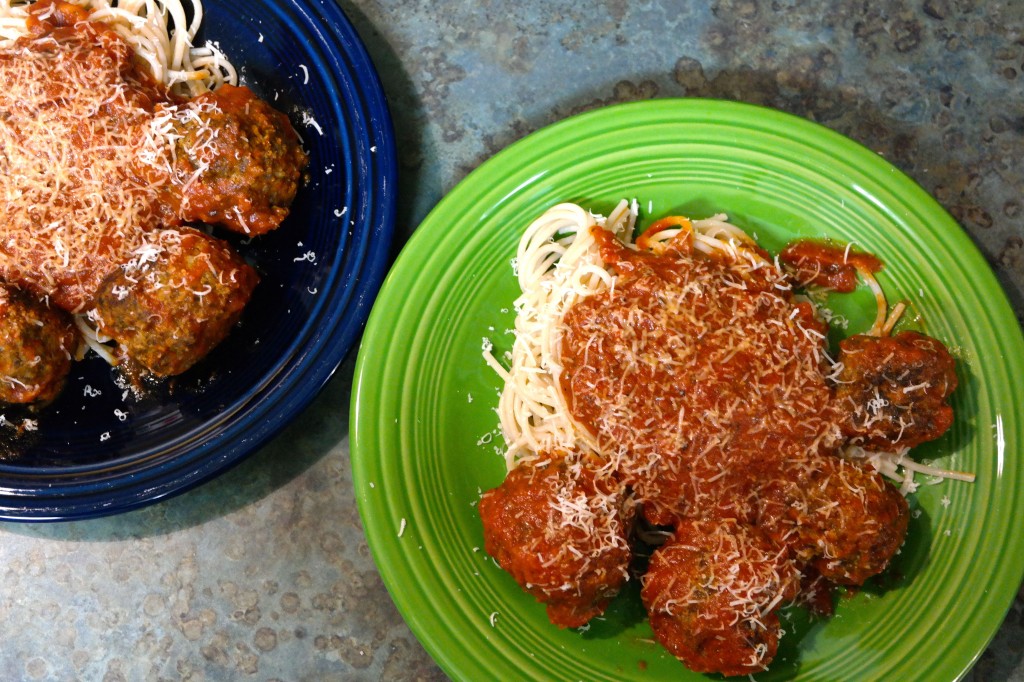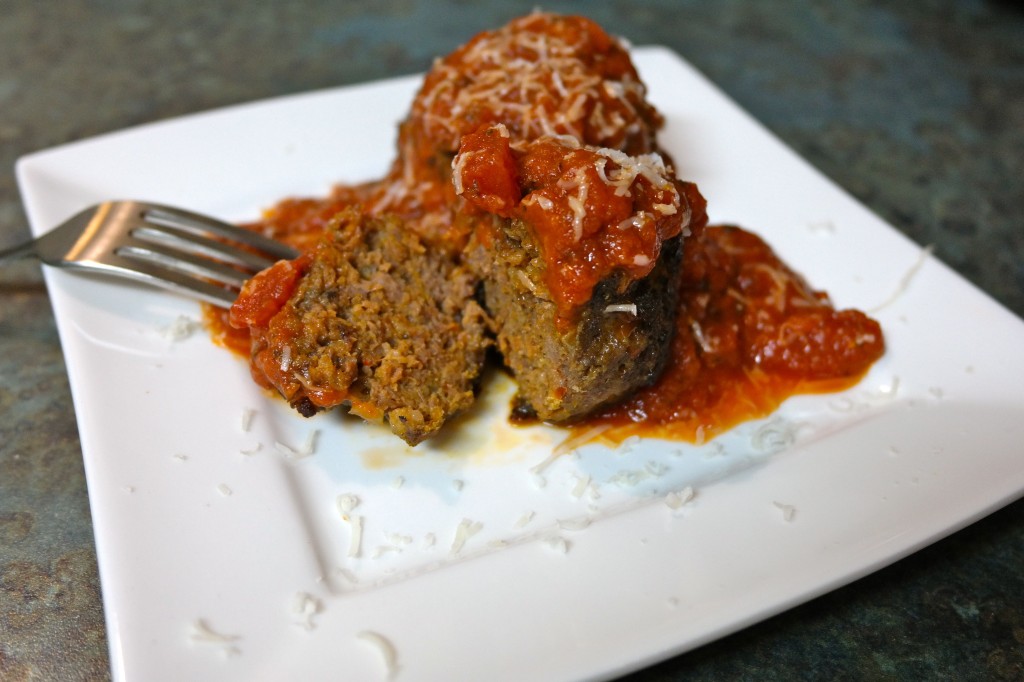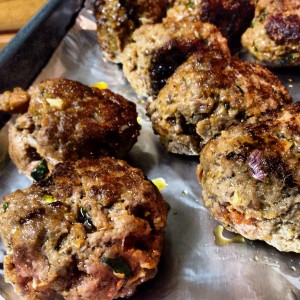
- My hubby’s favorite meal we learned to make gluten-free.
It’s that time of year again. Resolutions are made, then subsequently broken. Does that sound overly pessimistic — or all too familiar? Most of us pledge some sort of diet-related New Year’s resolution, like no more sugar or coffee or carbs, all in an effort to rewind our bodies back to before we added on that little winter padding. But what if you were forced to make a diet change, not just to lose weight or get more energy, but because something you’ve been eating is now your enemy?
This past year I’ve been on a journey of my own. Well, let’s say I’ve been along for the ride on my husband’s journey. After months of dating, which lead to months of newly wedded bliss (yes, it was a quick turnaround), I started to wonder … He had frequent migraines, sometimes waking up with headaches that forced him to call off of work. His tummy hurt almost every evening with sharp pains and bloating. Sometimes he would let me in on how he was feeling, but most of the time he suffered in silence, chewing on Tums or popping strong doses of migraine medicine. This was not normal, nor was it healthy.
Then the pieces started to fall into place. An uncle had Celiac disease. An older sister suspected she had it as well and has been gluten-free for 18-plus years. Could he have the disease as well? Or might he have gluten intolerance? What’s the difference between the two? And what is gluten anyway?
What is Celiac disease?
Much of the medical community agrees that 1 percent of the population has Celiac disease and, on top of that, roughly 6 percent more have a gluten intolerance. The disease is a hereditary autoimmune disorder that prevents the body from breaking down gluten, a protein found in wheat, rye and barley (the most prominent sources). It’s diagnosed with a blood test, followed up with an intestinal biopsy.
 Gluten intolerance is much trickier! It mimics Celiac disease’s symptoms but cannot be diagnosed. In this case, an elimination diet and closely monitoring how your body reacts is the best course of action.
Gluten intolerance is much trickier! It mimics Celiac disease’s symptoms but cannot be diagnosed. In this case, an elimination diet and closely monitoring how your body reacts is the best course of action.
So I broached the subject with my husband -– might all of these symptoms be a huge message your body is sending you? Some nutritionists and doctors believe that the intolerance may be genetic … and he has two relatives, after all, who are now gluten-free. So we gave it a go. Well, he gave it a go.
Should you go gluten-free?
Ten years ago, it was rare to hear of people going gluten-free unless you happened to know someone with Celiac disease and you rarely saw gluten-free products in supermarket aisles. It has since become a sort of fad diet thing. “Remove gluten and shed pounds and gain energy and feel amazing!” some seem to claim. But gluten is not everyone’s enemy and partaking in this lifestyle should not be taken lightly.
Gluten is not generally bad for people. Eating copious amounts of white bread and birthday cake and other processed gluten-y products is bad, though, so everyone will feel better cutting those things out of their diets. But if you do not need to be gluten-free, don’t do it. Just eat healthier forms of gluten, like whole grains and anything not heavily processed.
If you suspect you have the disease or intolerance, see a doctor and/or nutritionist. I’ve even encountered people who have eliminated gluten to combat auto-immune disorders such as Lyme disease, as gluten-y foods can have an inflammatory effect on the body.
What did we discover?
The real challenge is flipping your focus away from what you cannot have and onto what you can have. Chocolate? Yes, thank goodness. Steak? Yes, just watch the sauces and marinades for soy sauce and other sneaky gluten-filled ingredients. Vegetables and fruit and milk and eggs and cheese? All OK. Turns out, there’s still a lot to eat. Just make sure you’re eating a balanced diet, read your labels and educate yourself. The Gluten Free Girl blog has a great introduction.
I’ve altered my diet only slightly, but my husband has completely eliminated gluten from his diet. Having my sister-in-law as a resource has helped tremendously. Having lived gluten-free for almost two decades, she knows what to avoid (after drinking a particular flavor of Naked juice with wheat grass she felt terrible, for example) and which products are the best (Tinkyada brown rice pasta has the best pasta-like texture).

- Jim’s journey has brought us closer together – another food adventure.
Now when we get together, it seems like conversation swirls around our new gluten-free discoveries: boxed brownie mixes, recipes and clever ingredient swaps. Her challenge is cooking for her two children, who do not yet have any gluten intolerance symptoms. Even explaining to her three-year-old why mommy can’t try a bit of his super-yummy cookie is a challenge, but she’s a pro at it now!
It’s been an uphill journey, but well worth it. In the almost-year that he’s been gluten-free, my husband’s health has improved immensely. No more daily migraines and his tummy is no longer upset. Without gluten, his body is starting to heal itself.
Still, when something slips through the cracks he feels it the next day, or two. (Most recently it was corn flakes! Here’s a tip -– the second ingredient is gluten-rich malt. Ouch! But no worries — other brands, such as Nature’s Path, make gluten-free equivalents.)
So we’ve learned that giving up gluten is really not that hard. We’re working on finding replacements for the foods that are important to my husband, but most things have simply fallen out of his diet, which makes him healthier in general -– no more fast food, nothing breaded and fried, no bagels or muffins. We work to figure out foods that are important, like gluten-free cornbread stuffing at Thanksgiving and the meatballs that I’m sharing down below. And he’s lost weight too, a positive side effect. It’s a journey we continue to take into the New Year and beyond.
Gluten-Free Meatballs
Meatballs are one of my husband’s favorite foods … so it was one of the first meals we attempted to make gluten-free. The trick is the binder. We found using a basic gluten-free cereal worked very well, as we had it on hand, but gluten-free breadcrumbs or oats would work just as well here.
1 tablespoon salt
1 teaspoon paprika
1 teaspoon oregano
1/2 teaspoon marjoram
1/2 teaspoon ground thyme
1/4 teaspoon pepper
2 cups gluten-free plain cereal
1 large shallot, chopped
4 cloves garlic, chopped
7 to 10 fresh basil leaves, chopped
Parmesan cheese
2 pounds hamburger
1 pound ground sausage
1 egg
olive oil (for cooking)Add salt, paprika, oregano, marjoram, thyme, pepper and cereal into a blender. Blend into a flour-like consistency.
Combine hamburger and sausage in a large bowl. Add the cereal-spice mix along with the chopped ingredients into the bowl. Add egg. Shred Parmesan cheese on top of the mixture, adding as little or as much as you prefer.
Using your hands, mix all ingredients together until well combined. Roll the mixture into 3- to 4-inch balls.
Heat olive oil in a large skillet (I use cast iron). Brown meatballs for a few minutes on each side.
Remove from oil and place into a covered baking dish. Bake meatballs for 25 to 30 minutes at 375 degrees.
Remove from oven and serve over gluten-free pasta with sauce.





[…] way healthier (see all the benefits listed above). Also, it’s pizza! You may remember from my previous posts that my husband is gluten free. So, we haven’t seen many pizzas around our house the last few […]